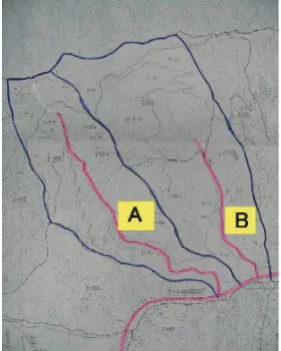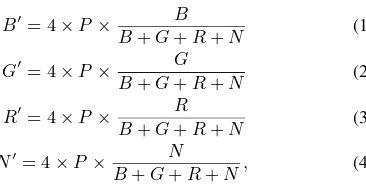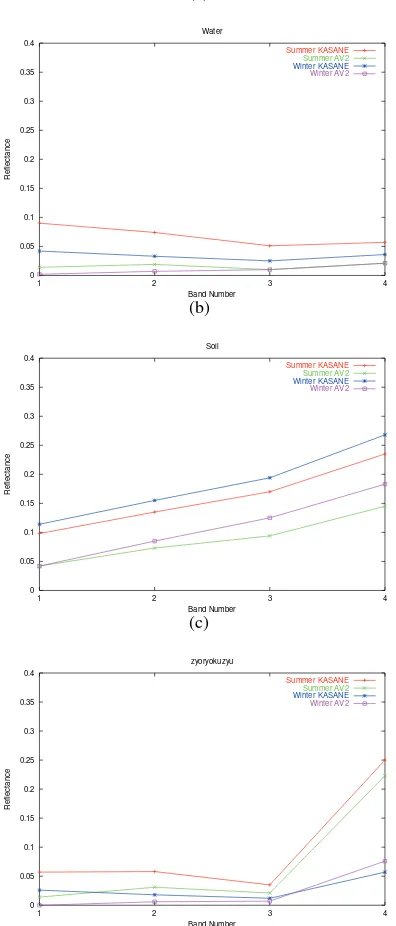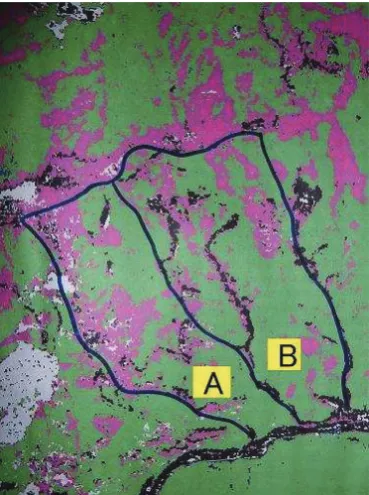VEGETATION TYPES MAPPING USING ALOS/AVNIR-2 AND PRISM DATA USING
UNIVERSAL PATTERN DECOMPOSITION METHOD
K. Muramatsua,b, K. Masugib, N. Soyamac, S. Furumid, M. Daigoe
aKYOUSEI Science Center for Life and Nature, Nara Women’s Univ., Kita Uoya Nishi Machi, Nara, 630-8506
b
Dept. of Information and Computer Sciences, Nara Women’s Univ., Kita Uoya Nishi Machi, Nara, 630-8506
c
Tenri University, 1050 Somanouchi, Tenri, Nara, Japan, [email protected]
d
Preschool education, Nara Saho College, 806 Rokuyaon-cho, Nara, 630-8565, Japan [email protected]
eFaculty of Economics, Doshisha University, Karasuma Higashi-iru Imadegawa-dori Kamigyo-ku, Kyoto, Japan
Commission VIII/8
KEY WORDS:pan-sharpen processing, reflectance characteristics
ABSTRACT:
Vegetation species maps are useful for forestry managements and environmental ecological study. From the forestry management, broad and conifer leaf forest should be mapped. In addition to them, land-cover mapping data with high resolution is needed as validation data sets for low resolution’s land-cover mapping results. SGLI sensor on board GCOM-C satellite, which will be launched in 2014, has 250m spatial resolution and it’s data will be used for making global land-cover data set. ALOS satellite was launched in 2006. It has AVNIR-2 sensor and PRISM sensor. AVNIR-2 sensor has four spectral bands 460, 560, 650 and 830nm with 10-m spatial resolution. PRISM sensor has panchromatic band from 520nm to 770 nm with 2.5m spatial resolution. If use the both of image, pseudo high spatial multi-spectal image can be processed. Because of the spatial resolution and multi-spectral information, these sensor data are expected to useful for making high resolution land-cover data set. We have developed Universal Pattern Decomposition Method (UPDM)( Zhang, L.F. et.al, 2006 (Zhang et al., 2006)) and Modified Vegetation Index based on UPDM (MVIUPD)(Zhang, L.F. et. al, 2007 (Zhang et al., 2007) and Xiong, Y., 2005 (?)) for satellite sensor data analysis for land cover mapping and vegetation monitoring. In the UPDM method, three coefficients of water, vegetation and soil is calculated using three standard patterns of water, vegetation and soil. One of this method’s characteristics is the UPDM coefficients from different sensors for the same object being same as each other. The capability of vegetation species mapping was studied with ALOS/AVNIR-2 data and UPDM method. Japanese cedar, Japanese cypress, deciduous forest, bamboo forest, orchard and grass land can be classified using AVNIR-2 summer and winter data. In this study, AVNIR-2 and PRISM data are used for vegetation types mapping using universal pattern decomposition method. Firstly, the pan-sharpen image was processed using AVNIR-2 and PRISM data. Each band’s Digital Number (DN) value of AVNIR-2’s band is calculated using DN of PRISM and AVNIR-2. The reflectance of AVNIR-2 is calculated from calculated DN values. UPDM method is applied to the set of re-calculated reflectance. Using the coefficients of UPDM and vegetation index, evergreen forest and deciduous forest were classified using two seasonal data. These results are compared with forest resource information. The tendency was agree with each other, although detailed validation is needed. From these results, the UPDM method can be applied to pan-sharpen image and the pan-sharpen image can be used for vegetation type classification. In the near future, calculation methods with retaining the original reflectance should be improved.
1 INTRODUCTION
Vegetation species maps are useful for forestry managements and environmental ecological study. From the forestry management, broad and conifer leaf forest should be mapped. In addition to them, land-cover mapping data with high resolution is needed as validation data sets for low resolution’s land-cover mapping re-sults. SGLI sensor on board GCOM-C satellite, which will be launched in 2014, has 250m spatial resolution and it’s data will be used for making global land-cover data set. ALOS satellite was launched in 2006. It has AVNIR-2 sensor and PRISM sen-sor. AVNIR-2 sensor has four spectral bands 460, 560, 650 and 830nm with 10-m spatial resolution. PRISM sensor has panchro-matic band from 520nm to 770 nm with 2.5m spatial resolution. If use the both of image, pseudo high spatial multi-spectral image can be processed. Because of the spatial resolution and multi-spectral information, these sensor data are expected to useful for making high resolution land-cover data set. We have developed Universal Pattern Decomposition Method (UPDM)( Zhang, L.F.
pattern decomposition method.
2 STUDY SITE AND USED DATA
2.1 Study site
Study site is the basin of tributary of Miyagawa River in Mie, Japan. The map of forest management is shown in Figure 1. The area A and B are the study site as shown in Figure 1. Pink line shows the rivers and blue line the ridge. From the forest manage-ment record in 2003, the cover ratio of artificial forest of ever-green such as Japanese cedar and Japanese cypress is 58.2 % for the area A, and 97.8 % for the area B.
Figure 1: The map of the forest management. Study area are shown in site “A” and “B”.
2.2 Used data in this study
In this study, ALOS/2 and PRISM data are used. AVNIR-2 sensor has four spectral bands from visible to near-infrared, such as 0.42∼0.50, 0.52∼0.60, 0.61∼0.69, and 0.76∼0.89µm
with 10∼15mspatial resolution. PRISM sensor has one band from visible to near-infrared such as 0.52∼0.77 µm with 2.5
m spatial resolution, and has three different angle observation modes. In this study, the nadir observation mode data was used. In order to make clear pan-sharpen image, the both of AVNIR-2 and PRISM data observed on the same day or in the same sea-son are needed. Fathermore in order to make classification of evergreen and deciduous forest, winter and summer data sets are needed. Because of the observing condition limit and the weather condition, there were not good both sensor’s data observed on the same day. As for the winter data, AVNIR-2 data observed on Jan. 29, 2009 and PRISM data observed on Oct. 24, 2006 were used. As for the summer data, AVNIR-2 data observed on Sep. 16, 2009 and PRISM data observed on July 27, 2007 were used. The images of study area are shown in Figure 2. Figure 2 (a) is the false color image of AVNIR-2 and (b) is the panchromatic image of PRISM for the summer and (c) of AVNIR-2 and (d) of PRISM for the winter data sets.
3 METHOD
3.1 Pan-sharpen processing
Two images of AVNIR-2 and PRISM of the same season was registered using control points with affine transfer mapping equa-tions. Brightness values of pan-sharpen image is calculated as
(a)
(b)
(c)
(d)
follows. band 2, band 3 and band 4, respectively. New DN values are used for calculating brightness and the reflectance for each bands. The cross section of Rayleigh scattering ( Hill and Stum, 1991, (Hill et al., 1991) ) was calculated for each bands with the condition of the solar zenith angle and Earth-Sun distance for each image data and subtracted.
3.2 Universal Pattern Decomposition Method
Using the spectral reflectance data, the Universal Pattern Decom-position Method (UPDM) coefficients are calculated. The method is based on the pattern decomposition method (PDM)(Fujiwara 1996, (Fujiwara et al., 1996) Muramatsu 2000 (Muramatsu et al., 2000), Daigo 2004 (?) ). In the PDM framework, the normaliza-tion of standard patterns depends on how many bands and which wavelengths the sensor observes. As the results the obtained pat-ten decomposition coefficients may differ for each sensor such as TM or GLI, even when the same sample is observed. Since the same normalized spectral patterns for any sensor is used in UPDM. In the UPDM, the same value of the coefficients can ob-tained for results measured by different sensor such as TM or GLI. The method is briefly explained in this section.
The set of spectral reflectance values (R1, R2, . . . , Rn) ofnbands
for a pixel is transformed into four coefficients such as water (Cw), vegetation (Cv), soil (Cs) with three standard spectral shape patterns. In the three standard spectral shape patterns, three are correspond to typical ground objects, namely water (Piw), veg-etation (Piv) and soil (Pis). The general equation of universal PDM was as follows:
Ri→CwPiw+CvPiv+CsPis . (5)
In UPDM, the standard pattern was defined using the continuous spectral function from 350nm to 2500nm, as follows:
|Pk(λ)dλ|=
dλ (k=w, v, s) . (6)
Here dλrefers to integration of the total wavelength range, and
Pk(λ)is defined as
Pk(λ) =
dλ
|Rk(λ)|dλRk(λ) (k=w, v, s) . (7)
For each sensor band, the standard patters are defined by
Pik=
whereλsiandλei are the start and end wavelength for bandi, respectively, andλsiλeidλis the wavelength with of bandi. The decomposition coefficients were obtained for each sensor by the
0
Figure 3: The three standard patterns of UPDM for ALOS/AVNIR-2 sensor.
least squares method using the equation 5. The standard patterns for ALOS/AVNIR-2 sensor are shown in Figure 3.
The modified vegetation index based on UPDM was determined as follows:
M V IU P D=(Cv−0.2Cs−C4−Cw)
Cw+Cv+Cs . (9)
It is determined to have linear relationship with vegetation cover and with the quantity of photosynthesis ( XIONG Yan 2005, L.F.Zhang et al., 2004 ).
4 RESULTS AND DISCUSSION
4.1 Characteristics of reflectance and UPDM coefficients of land cover objects for pan-sharpen image
The characteristics of reflectance for typical land cover objects are studied for pan-sharpen image and original AVNIR-2 image. The reflectance of water, soil, and evergreen forest are shown in Figure 4 (a), (b) and (c), respectively. Red line shows the pan-sharpen of summer image, and blue that of winter image. Green line shows the original AVNIR-2 of summer image, and pink that of winter image. The reflectance of pan-sharpen processing is higher than that of original AVNIR-2. Since the pan-sharpen pro-cessing was calculated using DN values, the original reflectance value was not constant. For using the reflectance values of pan-sharpen image, the improvement is needed for the pan-pan-sharpen processing. Although the reflectance was not constant after the processing, reflectance pattern was not changed. Since the these data sets are used to calculate UPDM coefficients.
The results of UPDM coefficients calculation using the same sam-ples of Figure 4 is shown in Figure 5. The three coefficients of water, soil, evergreen forest are shown in Figure 5 (a), (b) and (c), respectively. Line colors meaning is the same as in the case of Figure 4. For the water samples, three coefficients values are lower than 0.04. For soil samples, soil coefficients are highest among three coefficients. For vegetation samples, vegetation co-efficients are highest among three coco-efficients.
4.2 Classification threshold determination
(a)
Figure 4: Reflectance for water samples (a), soil (b) and forest (c).
sum of three coefficients are shown in Figure 6 (a), (b) and (c), respectively. As shown in Figure 6 (a), water samples ( dark blue for summer and light blue for winter ) are clustered MVIUPD lower than 0. and the sum of three coefficients are lower than 0.05. As shown in Figure 6 (b), soil samples ( red for summer ) are clustered vegetation coefficients lower than 0.15 and MVI-UPD lower than 0.6 and higher than -0.2. As shown in Figure 6 (c), evergreen samples are clustered soil coefficients lower than 0.01. Yellow plots are samples of deciduous in winter. They are divided from soil samples using the function of the soil coeffi-cients.
Using these characteristics, the classification threshold were de-termined as follows. Firstly, water area is classified with the con-dition of MVIUPD<0 and MVIUPD>-0.6 and the sum of three coefficients are higher between from 0 to 0.05 for summer or winter image. Secondly, soil area is classified with the con-dition of MVIUPD<0.6 and MVIUPD>-0.2, andCv<0.6
(a)
Figure 5: UPDM coefficients for water samples (a), soil (b) and forest (c).
and MVIUPD>-0.2 for summer or winter image. Thirdly, de-ciduous forest area is classified with the condition ofCwinter
s ≥
0.01 and the sum of coefficients are higher than 1.84×Cs-0.02. Finally, evergreen area is classified with the condition of -0.05> Cv<0.01.
4.3 Classification results and validation
(a)
Figure 6: The relationship between (a) MVIUPD vs. the sum of three coefficients, (b) MVIUPD vs. soil coefficients, and (c) soil coefficient vs. the sum of three coefficients.
5 CONCLUSIONS AND FUTURE WORK
Firstly, the pan-sharpen image was processed using AVNIR-2 and PRISM data. Each band’s Digital Number (DN) value of AVNIR-2’s band is calculated using DN of PRISM and AVNIR-2. The reflectance of pan-sharpen image is calculated from DN values. UPDM method is applied to the set of re-calculated reflectance. Using the coefficients of UPDM and vegetation index, evergreen forest and deciduous forest were classified using two seasonal data. These results are compared with forest resource informa-tion. The tendency was agree with each other, although detailed validation is needed. From these results, the UPDM method can be applied to pan-sharpen image and the pan-sharpen image can be used for vegetation type classification. In the near future, cal-culation methods with retaining the original reflectance should be improved.
Figure 7: The mapping result for study site. green area shows ev-ergreen forest, pink deciduous forest, black soil, blue water white cloud. Dark blue line shows the ridge.
ACKNOWLEDGEMENTS
The authors would like to thank Dr. Takuya Sato, KYOTO Uni-versity for proving the forest management information. This work was supported by Japan Aerospace Exploration Agency ( JAXA ) as ALOS project.
REFERENCES
Aoi, M., Muramatsu, K., Furumi, S., Daigo, M., Study on land cover classification using universal pattern decomposition method, A study on algorithm for estimation of global terrestrial net primary produuction using satellite sensor data, Doshisha University, World Wide Business Review, Vol. 8, No. 1, 78-92, 2006
Aoi, M., Muramatsu, K., Furumi, S., Daigo, M., Study on appli-cability to Landsat/MSS of the universal pattern decomposition method, Doshisha University, World Wide Business Review, Vol. 9, No. 1, 137-152, 2007
Daigo,M., A. Ono, R. Urabe, and N. Fujiwara : Pattern decom-position method for hyper-multispectral data analysis, Int. J. of Remote Sensing, 25(6), pp.1153–1166, 2004.
Fujiwara,N., K. Muramatsu, S. Awa, T. Hazumi, and F. Ochiai : Pattern expansion method for satellite data analysis (in Japanese), J. Remote Sens. Soc. Japan, 16(3), pp.17–34, 1996.
Hill, J., and Sturm, B., Radiometric correction of multitemporal Thematic Mapper data for useJ. Remote Sens. Soc. Japan, 16(3), pp.17–34, 1996.
Muramatsu,K., S. Awa, A. Hayashi, N. Fujiwara, M. Daigo and F. Ochiai : Pattern decomposition method in the albedo space for Landsat/TM and MSS data analysis,International Journal of Remote Sensing, 21(1), pp.99–119, 2000.
Xiong Yan, A study on algorithm for estimation of global ter-restrial net primary produuction using satellite sensor data, Doc-toral thesis, The division of Integrated Sciences, Nara Women’s University,2005.
Zhang,L.F., S.Furumi, K.Muramatsu, N.Fujiwara, M.Daigo, and L.P.Zhang. : (International Journal of Remote Sensing, submit-ted.) Sensor-independent analysis method for hyper-multi spectra based on the pattern decomposition method, (International Jour-nal of Remote Sensing, Vol. 27, 4899-4910, 2006



